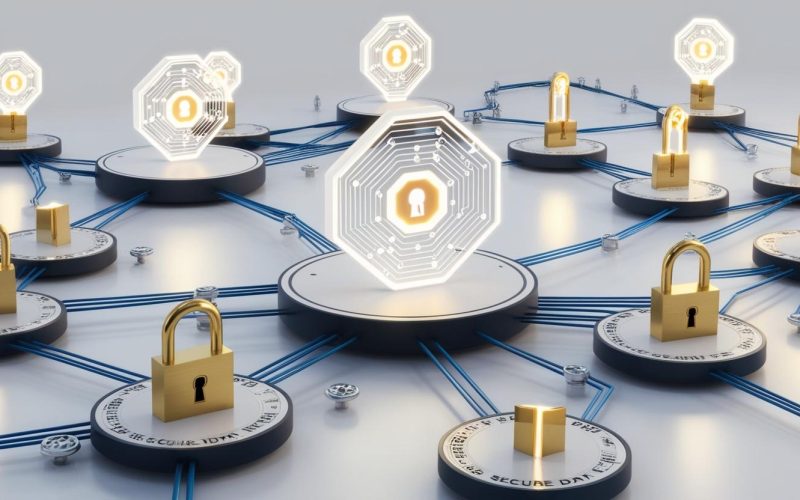As blockchain technology evolves beyond cryptocurrencies and speculative trading, a powerful and often overlooked application is rapidly gaining traction: decentralized identity (DID). In a world where data breaches, identity theft, and intrusive surveillance are daily concerns, blockchain-powered identity systems promise to put people back in control of their personal information. This emerging frontier could radically shift how we prove who we are, access services, and safeguard privacy online.
Today, millions of people already trust blockchains to store and transfer value securely. But the same principles that keep your cryptocurrency safe can also protect your digital identity. Just as choosing the best crypto wallet app ensures your funds stay secure and accessible, adopting a decentralized identity solution can help you manage your personal data on your own terms without relying on centralized corporations that profit from your information.
The Problem with Centralized Identity
The traditional identity model is built on centralized silos. Governments issue passports and IDs, tech giants hold your logins and activity logs, and third-party services constantly request copies of your sensitive documents. Every time you sign up for a new app or website, your personal data is duplicated and stored in countless databases — each one a potential target for hackers.
High-profile breaches like the Equifax hack in 2017 and repeated leaks from social media platforms highlight the flaws in this system. Beyond security risks, the centralized model also puts your privacy at the mercy of corporations and governments. Data mining, targeted ads, and surveillance capitalism thrive because individuals have little control over how their data is collected and used.
What is Decentralized Identity?
Decentralized identity flips this model on its head. Instead of storing identity data in a single company’s server, DID uses blockchain technology to let individuals create, manage, and verify their identities without an intermediary.
At its core, a decentralized identity is a self-owned, cryptographically secured profile stored on a distributed ledger. It usually includes verifiable credentials issued by trusted parties — for example, a university can issue a digital diploma, or a government can provide a digital passport. Only you hold the keys to share this information when needed.
Key Components of DID
To understand how DID works, it helps to know its three main parts:
-
Decentralized Identifiers (DIDs): Unique strings (like a blockchain address) that represent an individual or entity. Unlike usernames or emails, DIDs aren’t tied to a single database or service provider.
-
Verifiable Credentials: Digitally signed statements that confirm facts about you — such as your age, citizenship, or educational degree — without exposing unnecessary personal details.
-
Blockchain Ledger: The distributed system that anchors the identifiers and credentials, making them tamper-proof and publicly verifiable without storing the actual private data on-chain.
Blockchain Fundamentals for Data Ownership
Blockchain is a distributed ledger where all participants hold a copy of the same records. Key features include:
-
Decentralization: No single entity controls the network.
-
Immutability: Once data is added, it cannot be altered without detection.
-
Cryptographic Security: Data entries are signed with private keys, ensuring authenticity.
By storing data references (not full records) on-chain, the system ensures integrity while keeping sensitive details off public ledgers. This model lays the groundwork for decentralized data control.
Self-Sovereign Identity (SSI)
Self-sovereign identity puts individuals in charge of their digital identities. With SSI:
-
Users Create Their Own IDs: Instead of login/password models, users generate cryptographic keys.
-
Selective Disclosure: People share only the data needed for a transaction (e.g., age or citizenship) without revealing full identity.
-
Verifiable Credentials: Third parties—like universities or banks—issue cryptographically signed credentials that users store in digital wallets.
SSI removes the need for central identity providers. Users control when and how their personal credentials are used.
Real-World Use Cases
Decentralized identity is not just theory — it’s already finding practical applications in various industries:
-
Financial Services: Banks and crypto exchanges can use DID for streamlined KYC (Know Your Customer) processes, reducing fraud while enhancing user privacy.
-
Healthcare: Patients can control access to their medical records, sharing them securely with doctors, hospitals, or insurers without data silos.
-
Travel: Travelers could pass through airport security and immigration using blockchain-verified credentials, cutting down on paperwork and waiting time.
-
Education and Employment: Employers and schools can verify degrees and professional certifications instantly, eliminating fake resumes and diploma fraud.
Major organizations, including Microsoft’s ION network and the European Union’s eIDAS framework, are actively developing standards and pilot programs for decentralized identity systems.
Benefits for Users and Businesses
For individuals, the primary benefit is sovereignty. You decide who can see your data, when, and for how long. This minimizes the chances of your information being misused or sold.
For businesses, DID streamlines onboarding and verification. Companies spend billions each year on identity management and compliance. With decentralized identity, verifying a new user could be as simple as checking a cryptographic proof instead of collecting and storing sensitive data.
Challenges to Widespread Adoption
Despite its promise, decentralized identity still faces technical and social hurdles:
-
Interoperability: Many projects use different standards. To work globally, DIDs must be compatible across borders and industries.
-
User Experience: Key management and cryptography can be intimidating. Making DID as simple as logging in with an email or social account is essential for mainstream use.
-
Regulation: Governments must adapt legal frameworks to accept decentralized credentials, balancing innovation with security and compliance.
Privacy advocates also warn that careless implementation could inadvertently expose more data or create new forms of surveillance. Therefore, robust design and open standards are critical.
Market Trends and Growing Momentum
According to industry reports, the decentralized identity market is expected to grow significantly over the next five years, driven by increasing data privacy concerns and regulatory pressures like GDPR. Tech giants such as IBM and governments alike are investing in pilot programs and standardization efforts.
In the crypto space, DID is also becoming a cornerstone of Web3 — the vision of a user-owned internet where data and identity are portable and under individual control. NFT marketplaces, DAOs (Decentralized Autonomous Organizations), and decentralized social networks all benefit from verifiable, self-sovereign identities.
How to Get Started with Decentralized Identity?
Curious about trying decentralized identity for yourself? Here are a few steps to explore the ecosystem:
-
Learn the Basics: Familiarize yourself with concepts like DIDs, verifiable credentials, and zero-knowledge proofs.
-
Test Wallets and Tools: Some crypto wallets and Web3 browsers are beginning to integrate DID functionality, allowing you to create and manage your identifiers alongside your crypto assets.
-
Explore Use Cases: Join communities or pilot programs experimenting with DID, whether for travel, education, or online services.
-
Stay Updated: Follow developments from the W3C Decentralized Identifiers Working Group and major blockchain networks to keep up with new standards and partnerships.
Final Thoughts
Decentralized identity is poised to be one of the most transformative applications of blockchain technology, putting privacy and data ownership back into the hands of individuals. As more services adopt this approach, the days of repeating your personal information for every signup or worrying about data leaks may finally become a thing of the past.












